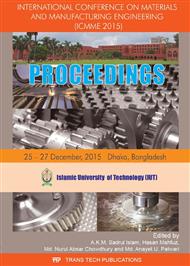p.1
p.7
p.13
p.19
p.25
p.30
p.35
p.41
Effect of Heat Treatment on Low Carbon Steel: An Experimental Investigation
Abstract:
In engineering metallurgy, heat treatment of steels is one of the most important factors as it enhances various physical and mechanical properties which are considered handy in numerous structural applications. Heat treatment is basically the combination of operations involving the heating and cooling of a metal or alloy in solid state for obtaining required microstructures by refining the grain size and a combination of properties. The prime object of this investigation is to illustrate the effect of heat treatment on low carbon steel (AISI 1020) to expose its mechanical (hardness) and microstructural (microstructures) properties. For this purpose, cylindrical shaped AISI 1020 steel specimens were used. The samples were polished using a specimen polishing machine and heated in a heat treatment furnace at approximately 950°C for almost 2 hours and then cooled by different quenching media (Water, Air, Ash). After heat treatment (Hardening, Normalizing, Full Annealing) the Brinell hardness number (B.H.N) was determined using a Universal testing machine (U.T.M) and the microstructures were examined using a metallurgical microscope. It was observed that, due to hardening the resultant structure was a super saturated solid solution of carbon trapped in a body centered tetragonal structure called martencite which increased the hardness number of the steel specimens drastically making an extreme harder steel. Moreover, full annealing provided lower hardness value due to the presence of ferrite structure and normalizing provided moderate hardness value and ductility due to slow cooling.
Info:
Periodical:
Pages:
7-12
Citation:
Online since:
December 2016
Price:
Сopyright:
© 2017 Trans Tech Publications Ltd. All Rights Reserved
Share:
Citation:


